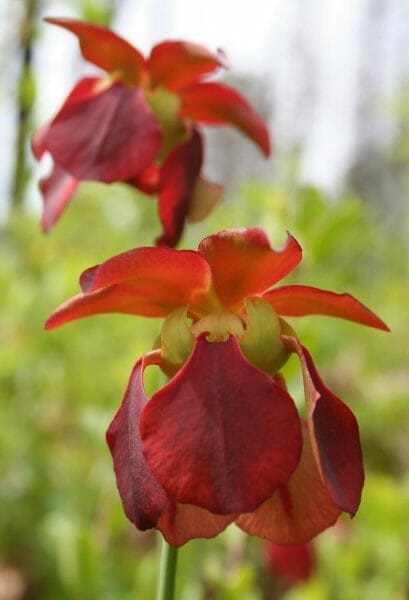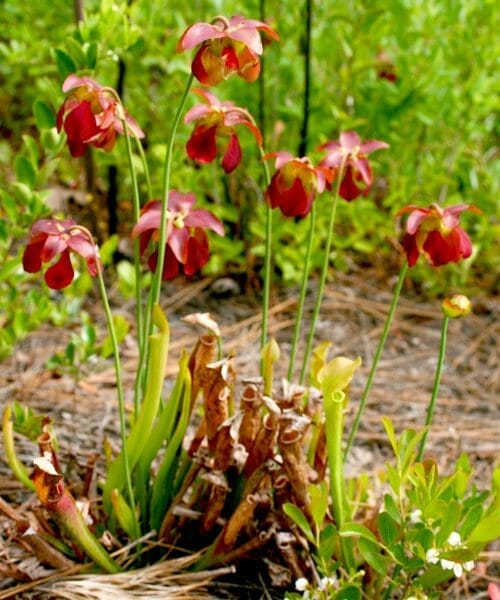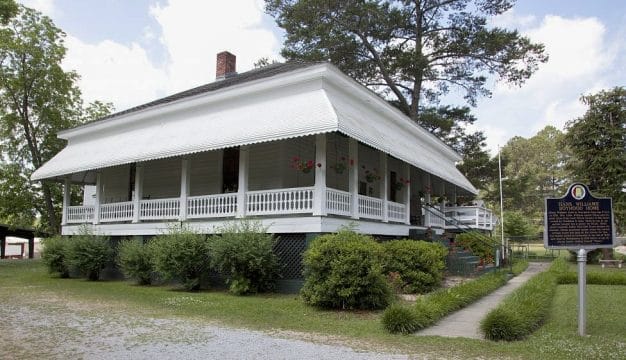Alabama Canebrake Pitcher Plant
The Alabama canebrake pitcher plant is a carnivorous plant that is unique to Alabama, growing in only Autauga and Chilton Counties in the central area of the state. It also was found in Elmore County in the past but no longer grows there. At one time this plant was found at 28 sites, but now plants are believed to survive at only 11 of them. Along with the green pitcher plant (Sarracenia oreophila), the canebrake pitcher plant is one of two Alabama pitcher plant species listed as endangered by the U.S. Fish and Wildlife Service.
 Alabama Canebrake Pitcher Plant
Alabama is among the most biologically diverse states in the nation, ranking fifth in total biodiversity and first in pitcher plants. Pitcher plants in the genus Sarracenia are an important component of the state’s carnivorous plant flora. Scientists who study these plants have disagreed about how to classify pitcher plants from central Alabama. Because of the red veins and other features of their pitchers and their maroon flowers, they were originally classified as Sarracenia rubra, the sweet pitcher plant, which is very similar. In 1974, the plants in central Alabama were named by Frederick and Roberta Case as a separate species (Sarracenia alabamensis), based upon the shape of the pitchers, the presence of fine hairs, and the greener color of the pitchers. But the central Alabama plants also have been considered a subspecies of S. rubra (S. rubra subsp. alabamensis) or a subspecies of S. alabamensis (S. alabamensis subsp. alabamensis). This last name separates these central Alabama plants from similar plants in coastal southwestern Alabama, southeastern Mississippi, and the western edge of the Florida Panhandle that are sometimes classified as S. alabamensis subsp. wherryi.
Alabama Canebrake Pitcher Plant
Alabama is among the most biologically diverse states in the nation, ranking fifth in total biodiversity and first in pitcher plants. Pitcher plants in the genus Sarracenia are an important component of the state’s carnivorous plant flora. Scientists who study these plants have disagreed about how to classify pitcher plants from central Alabama. Because of the red veins and other features of their pitchers and their maroon flowers, they were originally classified as Sarracenia rubra, the sweet pitcher plant, which is very similar. In 1974, the plants in central Alabama were named by Frederick and Roberta Case as a separate species (Sarracenia alabamensis), based upon the shape of the pitchers, the presence of fine hairs, and the greener color of the pitchers. But the central Alabama plants also have been considered a subspecies of S. rubra (S. rubra subsp. alabamensis) or a subspecies of S. alabamensis (S. alabamensis subsp. alabamensis). This last name separates these central Alabama plants from similar plants in coastal southwestern Alabama, southeastern Mississippi, and the western edge of the Florida Panhandle that are sometimes classified as S. alabamensis subsp. wherryi.
Pitcher plants are non-woody plants that grow from a horizontal underground stem called a rhizome. Their leaves are tube-shaped and somewhat reminiscent of an old-fashioned milk pitcher, hence their common name. The “pitchers” of the Alabama canebrake pitcher plant are yellow-green in color with reddish veins and often are copper colored on the upper part. The plant makes different sets of pitchers in spring and summer and produces flattened leaves called phyllodia as well during the growing season. The horizontal rhizome often forms offshoots that over time produce large clumps of pitchers that extend several feet out from the rhizome and enable these plants to reproduce asexually; this is an important adaptation because few seedlings reach maturity in the field.
 Pitcher Plant Flowers
In April and May, pitcher plants produce fragrant flowers with five maroon-colored petals. Each flower sits atop a long stalk that can reach up to two feet tall. Flowers are pollinated by large bees, such as bumblebees, attracted to the copious amount of pollen produced by each flower. Successfully pollinated flowers form a capsule containing hundreds of small light seeds that are scattered in fall by wind or water. Seeds that germinate successfully in spring produce miniature plants with pitchers an inch or less tall. Given proper amounts of light and moisture, they can grow rapidly into mature plants.
Pitcher Plant Flowers
In April and May, pitcher plants produce fragrant flowers with five maroon-colored petals. Each flower sits atop a long stalk that can reach up to two feet tall. Flowers are pollinated by large bees, such as bumblebees, attracted to the copious amount of pollen produced by each flower. Successfully pollinated flowers form a capsule containing hundreds of small light seeds that are scattered in fall by wind or water. Seeds that germinate successfully in spring produce miniature plants with pitchers an inch or less tall. Given proper amounts of light and moisture, they can grow rapidly into mature plants.
As with most plants, pitcher plants have chlorophyll in their leaves and harvest energy from sunlight using photosynthesis. But they grow in wet, highly acidic soils that are very low in important nutrients, such as nitrogen, that other plants typically absorb from soil. So they evolved the ability to catch and consume live prey to provide them with these nutrients. The funnel-shaped pitchers are topped with an extension, called a hood, that arches over the opening and helps keep rain out. The plants produce nectar near the opening of the tube that attracts insects and may even contain a chemical that drugs them so that they are more likely to fall into the pitcher. The interior wall of the pitcher is very smooth and waxy, with downward-pointing projections that make it difficult for prey to crawl up the wall once inside; it also contains wetting agents in the fluid to soak insect wings and keep them from working well. Insects trapped in the pitcher soon die and are digested by enzymes secreted into the pitcher fluid by the plant.
Alabama canebrake pitcher plants grow in wet sandy clay soils of seepage bogs. These bogs form over a shallow impervious layer of rock that forces water percolating down hillsides to the surface and holds it there. Most of the sites that host these plants are relatively small in area, from about 40 square feet up to an acre. Pitcher plants grow in association with many other plant species, including giant cane, a widespread native bamboo species that before European settlement formed dense stands in wetlands called canebrakes. This association is the source of the common name of S. alabamensis subsp. alabamensis. Other plants in the communities include sphagnum moss, yellow-eyed grass, bog hatpins, beak sedges, and many other non-woody plants. In general, pitcher plant bogs have a relatively high diversity of plant species.
 Clump of Pitcher Plants
Like many other Alabama species, the canebrake pitcher plant faces many threats. Since the species was first named in 1974, a total of 17 populations have been destroyed, with railroad and pond construction, livestock grazing, and conversion to pine plantations being the primary causes. Also, some of the sites hosting this plant contain gravel deposits that have been mined, directly destroying populations or changing the water table so the sites become drier. In addition to habitat destruction, pitcher plants (and indeed most carnivorous plants) are subject to poaching because people find them charismatic and interesting. Perhaps the most serious threat, however, is fire suppression. Prior to modern settlement, Alabama landscapes burned with regular frequency and most plants in those landscapes became adapted to living with occasional burning. Without frequent burning, bogs become invaded by wetland trees and shrubs that shade out the low-growing, sun-loving herbaceous plants on these sites.
Clump of Pitcher Plants
Like many other Alabama species, the canebrake pitcher plant faces many threats. Since the species was first named in 1974, a total of 17 populations have been destroyed, with railroad and pond construction, livestock grazing, and conversion to pine plantations being the primary causes. Also, some of the sites hosting this plant contain gravel deposits that have been mined, directly destroying populations or changing the water table so the sites become drier. In addition to habitat destruction, pitcher plants (and indeed most carnivorous plants) are subject to poaching because people find them charismatic and interesting. Perhaps the most serious threat, however, is fire suppression. Prior to modern settlement, Alabama landscapes burned with regular frequency and most plants in those landscapes became adapted to living with occasional burning. Without frequent burning, bogs become invaded by wetland trees and shrubs that shade out the low-growing, sun-loving herbaceous plants on these sites.
The Alabama canebrake pitcher plant was listed as federally endangered in 1989 because of the small number of sites, the small areas of each site, the small numbers of plants at most sites, and the many threats faced by the species. Fewer than a dozen sites currently host the plant and only five sites have populations of significant size (more than 30 clumps of plants). Two sites are preserved on The Nature Conservancy (TNC) of Alabama’s 400-acre Roberta Case Preserve in Autauga County, and the Boy Scouts of America also own a site with a large population in that county as well. The U.S. Fish and Wildlife Service and TNC are working with some landowners to help manage populations by reintroducing regular burning, and the Atlanta Botanical Garden is propagating some plants for conservation projects. In 2009, the Alabama Conservation Alliance and TNC established two small new populations on the site owned by the Boy Scouts of America. With continued conservation efforts, this unique Alabama carnivorous plant will continue to contribute to Alabama’s outstanding biodiversity.
Further Reading
- Case, Frederick W., Jr., and Roberta B. Case. “Sarracenia alabamensis, a Newly Recognized Species from Central Alabama.” Rhodora 76 (December 1974): 650-65.
- Chesser, Jason D., and J. Stephen Brewer. “Factors Influencing Seedling Recruitment in a Critically Endangered Pitcher Plant, Sarracenia rubra ssp. alabamensis.” Endangered Species Research 113 (March 2011): 245-52.
- Murphy, Patrick B., and Robert S. Boyd. “Population Status and Habitat Characterization of the Endangered Plant, Sarracenia rubra subspecies alabamensis.” Castanea 64 (June 1999): 101-13.
- Neal, Wendell A. Alabama Canebrake Pitcher Plant Recovery Plan. Jackson, Miss.: U.S. Fish and Wildlife Service, 1992.
- Mississippi Ecological Services Field Office. Alabama Canebrake Pitcher-Plant (Sarracenia rubra ssp. alabamensis). 5-Year Review: Summary and Evaluation. Jackson, Miss.: U.S. Fish and Wildlife Service, 2012.



